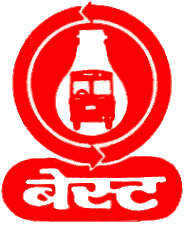Bombay Electric Supply & Tramways Company
 |
|

Electric House, Colaba, headquarters of BEST.
|
|
|
Formerly called
|
1873 as Bombay Tramway Company Limited (Horsecar) ---- 1905 as Bombay Electric Supply & Tramways Company Limited (BEST) (Tramways and Electricity) ---- 1947 as Bombay Electric Supply and Transport (BEST) (Transport and Electricity) ---- 1995 as Brihanmumbai Electric Supply & Transport (BEST) (Transport and Electricity) |
|---|---|
| Autonomous State-owned enterprise | |
| Industry |
Public transport - Tram (1873 - 1964), Bus (1926 - present) ---- Electricity (1905 - present) |
| Founded | Mumbai (1873) |
| Headquarters | Electric House, Colaba, Mumbai, Maharashtra, India |
|
Key people
|
Jagdish Patil, GM |
| Revenue |
|
|
Number of employees
|
44,000 (2005) |
| Parent | Municipal Corporation of Greater Mumbai |
| Website | www.bestundertaking.com |
The Brihanmumbai Electricity Supply and Transport (BEST) Undertaking is the civic transport and electricity provider public body based in Mumbai, Maharashtra, India. It was originally set up in 1873 as a tramway company called "Bombay Tramway Company Limited". The company, set up a captive thermal power station at Wadi bunder in November 1905 to generate electricity for its trams that positioned it to also supply electricity to the city and re-branded itself to "Bombay Electric Supply & Tramways (BEST)" Company. In 1926, the BEST also became an operator of motor buses. In 1947, a week prior to India gaining independence, the BEST became an undertaking of the Municipal Corporation and rebranded itself to "Bombay Electric Supply & Transport". In 1995, with the renaming the city from Bombay to Mumbai, the organisation was also renamed to "Brihanmumbai Electric Supply & Transport (BEST)". It now operates as an autonomous body under the Municipal Corporation.
The Undertaking operates one of India's largest fleets of buses. The bus transport service covers the entire city and also extends its operations outside city limits into neighbouring urban areas. In addition to buses, it also operates a ferry service in the northern reaches of the city. The electricity division of the organisation is also one of the few electricity departments in India to garner an annual gross profit.
The idea of a mass public transport system for Bombay was first put forward in 1865 by an American company, which applied for a licence to operate a horse-drawn tramway system. Although a licence was granted, the project was never realised, owing to the prevailing economic depression in the city. The end of the American Civil War, during which Bombay had made vast strides in its economy by supplying cotton and textiles to the world market, was the reason for the economic downturn. Later, on 27 November 1871, a notice in the Times of India newspaper put by the "Bombay Omnibus Service", proposed to set up a bus service between Malabar Hill and Fort. However, the proposed monthly pass fare of thirty pounds proved to be too expensive, and the tender was promptly abandoned.
The "Bombay Tramway Company Limited" was formally set up in 1873. After a contract was entered into between the Bombay Tramway Company, the municipality and Stearns and Kitteredge company, the Bombay Presidency enacted "The Bombay Tramways Act, 1874", under which the Company was licensed to run a Horsecar tramway service in the city. On 9 May 1874, the first horse-drawn tram made its début in the city, plying on the Colaba–Pydhone via Crawford Market, and Bori Bunder to Pydhonie via Kalbadevi routes. The initial fare was three annas (15 paise), and no tickets were issued. As the service became increasingly popular, the fare was reduced to two annas (10 paise). Later that year, tickets were issued for the first time, to curb the increasing ticketless travel. Stearns and Kitteredge reportedly had a stable of 900 horses when tram service began.
...
Wikipedia
